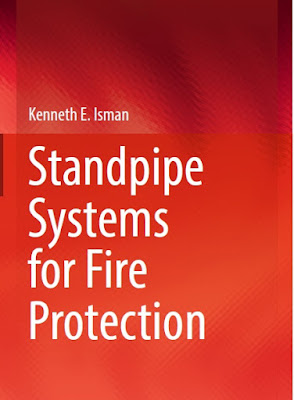Standpipe Systems for Fire Protection 2017
ABOUTStandpipe Systems for Fire Protectionauthor Kenneth E. Ismanpublisher Springer ISBN 978-3-319-47749-7
ITRODUCTION
There have been very few books written about standpipe systems in the 150-year history of water-based fire protection system design. In 1976, Dr. John Bryan published the first edition of his book, Automatic Sprinkler and Standpipe Systems. This book was an important step forward because it was the first book to dedicate significant space to the subject. But half of the book was dedicated to fire sprinkler systems, so there was not enough space in the book to get into some of the more complicated issues involved in standpipe system design. Over the years, Dr. Bryan’s book was updated with more information, but it still did not have the space to tackle the real complex issues. At the same time, standpipe systems were evolving and more codes and standards organizations were getting involved in writing their own requirements, which are sometimes contradictory. The time has come for a book dedicated to standpipe systems and nothing else so that all of the complicated issues can be discussed.This book pulls together all of the requirements for standpipe systems that can be found in the International Building Code, the International Fire Code, NFPA 14, NFPA 20, and NFPA 25 and attempts to make sense of them. In the situations where the requirements from one document contradict the rules of another, the hierarchy will be presented so that the reader will be able to determine which requirement is the one that needs to be followed.The life cycle of standpipe systems will be covered from beginning to end. The book opens with basic information on what standpipe systems are and a short history of standpipe systems. It continues with design information and special considerations for high-rise buildings and pressure control concerns. The book will wrap up with a discussion of how to conduct the acceptance tests for a new standpipe system and how to care for an existing standpipe system with periodic inspection, testing, and maintenance
ABOUT
Standpipe Systems for Fire Protection
author Kenneth E. Isman
publisher Springer
ISBN 978-3-319-47749-7
ITRODUCTION
There have been very few books written about standpipe systems in the 150-year history of water-based fire protection system design. In 1976, Dr. John Bryan published the first edition of his book, Automatic Sprinkler and Standpipe Systems. This book was an important step forward because it was the first book to dedicate significant space to the subject. But half of the book was dedicated to fire sprinkler systems, so there was not enough space in the book to get into some of the more complicated issues involved in standpipe system design. Over the years, Dr. Bryan’s book was updated with more information, but it still did not have the space to tackle the real complex issues. At the same time, standpipe systems were evolving and more codes and standards organizations were getting involved in writing their own requirements, which are sometimes contradictory. The time has come for a book dedicated to standpipe systems and nothing else so that all of the complicated issues can be discussed.
This book pulls together all of the requirements for standpipe systems that can be found in the International Building Code, the International Fire Code, NFPA 14, NFPA 20, and NFPA 25 and attempts to make sense of them. In the situations where the requirements from one document contradict the rules of another, the hierarchy will be presented so that the reader will be able to determine which requirement is the one that needs to be followed.
The life cycle of standpipe systems will be covered from beginning to end. The book opens with basic information on what standpipe systems are and a short history of standpipe systems. It continues with design information and special considerations for high-rise buildings and pressure control concerns. The book will wrap up with a discussion of how to conduct the acceptance tests for a new standpipe system and how to care for an existing standpipe system with periodic inspection, testing, and maintenance
Table of contents
1-Types and Classes of Standpipe Systems
2-Buildings Required to Have Standpipes
3-Installation Rules for Hose Connections
4-Installation Requirements for the Rest of the Standpipe System
5-Hydraulic Calculation of Standpipe Systems
6-Combined Sprinkler/Standpipe Systems
7-Pressure Control in Standpipe Systems
8-Pumps and Standpipe Systems
9-High Rise Buildings
10-Hanging, Bracing and Protection of System Piping
11-Horizontal Standpipes and Lateral Piping
12-Acceptance Testing of Standpipes
13-Periodic Inspection, Testing and Maintenance
14-Solutions to “Test Yourself” Exercises














Sir, #Link was dead, pls .
ReplyDeleteFires can begin all of a sudden and out of the blue from an open fire, dropped cigarette, fuel spill, blast, fire related crime, electrical breakdown, or lightning. מערכת גילוי אש אנלוגית
ReplyDeleteI recently came across your blog and have been reading along. I thought I would leave my first comment. I don’t know what to say except that I have enjoyed reading. fire extinguisher types
ReplyDeleteA very awesome blog post. We are really grateful for your blog post. You will find a lot of approaches after visiting your post. יועץ בטיחות באש
ReplyDelete